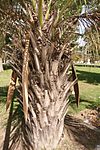Jelly palm facts for kids
Quick facts for kids Jelly palm |
|
|---|---|
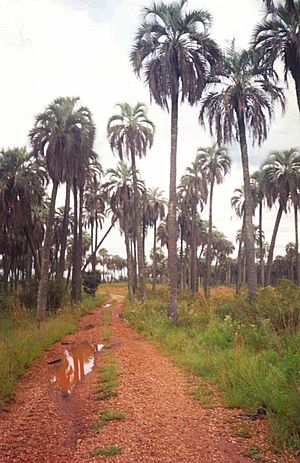 |
|
| Butia yatay palms in Parque Nacional El Palmar, Entre Ríos, Argentina | |
| Scientific classification | |
| Genus: |
Butia
|
| Species: |
yatay
|
| Synonyms | |
|
|
The Butia yatay palm, also known as the jelly palm or yatay palm, is a type of palm tree. It grows naturally in southern Brazil, Uruguay, and northern Argentina. In Brazil, people call it butiá-jataí or simply jataí or butiá.
This palm is sometimes grown as an ornamental plant in Europe and the United States. It is the tallest of all the Butia palm species. The fruit of the Butia yatay is edible and tastes sweet.
Contents
What's in a Name?
The scientific name of this palm comes entirely from Native American languages. The word Butia comes from a local Brazilian name. It likely means 'thorny thing' in Old Tupi, referring to the sharp spines on the leaf stems.
The second part of the name, yatay, comes from the Guaraní language. In Guaraní, yata'i is the word for these palms. It refers to their small, hard fruit.
How Scientists Classify This Palm
Scientists sometimes change how they classify plants. In 1970, a scientist named Sidney Fredrick Glassman moved this palm to a different group called Syagrus. But in 1979, he moved it back to the Butia group.
Other palms that were once thought to be separate species are now considered to be the same as Butia yatay. This includes B. missionera and B. quaraimana from Brazil. Also, B. noblickii from Argentina is now seen as the same species.
Palm Tree Features
This palm usually has a single trunk. The trunk often grows at a slight angle. It can be from 3 to 16 meters (about 10 to 52 feet) tall. Some can even reach 18 meters (about 59 feet). In Brazil, they are usually shorter, around 8 meters (26 feet).
The trunk is about 30 to 55 centimeters (12 to 22 inches) wide. It often keeps old leaf bases attached for many years.
Leaves of the Palm
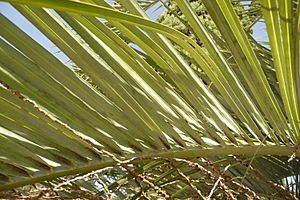
The palm has between 11 and 31 leaves. These leaves grow in a spiral pattern around the top of the trunk. The stem of each leaf is long, from 40 to 130 centimeters (16 to 51 inches). It has stiff, sharp teeth along its edges, which can be up to 4 centimeters (1.6 inches) long.
Each leaf has a main stalk that is 163 to 200 centimeters (64 to 79 inches) long. Along this stalk are 63 to 78 leaflets, which are usually a bluish-green color. These leaflets are about 65 to 77 centimeters (26 to 30 inches) long. They are arranged in a single flat line on both sides of the main stalk. This makes each pair of leaflets look like a "V" shape.
Flowers and Fruit
The flowers of the Butia yatay grow in a cluster called an inflorescence. This cluster is protected by a woody cover called a spathe. The spathe is about 105 to 135 centimeters (41 to 53 inches) long.
The flowers can be yellow, yellow-purple, greenish-yellow, or entirely purple. Male flowers are about 9-10mm long, and female flowers are about 13-17mm long.
Fruit and Seeds
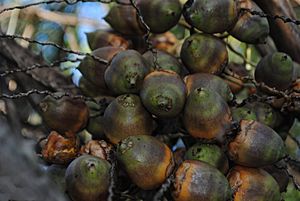
The fruit of the Butia yatay is oval-shaped. When ripe, it is about 2.7 to 4.2 centimeters (1.1 to 1.7 inches) long. It is also about 1.5 to 3.8 centimeters (0.6 to 1.5 inches) wide. Each fruit weighs about 8 to 23 grams (0.3 to 0.8 ounces).
The fruit can be yellow, orange, red, or purple. The inside flesh is yellow, sweet, juicy, and a little bit stringy. Inside the fruit is a hard nut. This nut usually has 1 to 3 seeds.
Comparing Similar Palms
The Butia yatay is similar to another palm called B. paraguayensis. However, Butia yatay is usually taller. It also has longer leaves with more leaflets. Its fruit is also larger than that of B. paraguayensis.
Where This Palm Grows
In Brazil, the Butia yatay grows only in the southernmost state of Rio Grande do Sul. You can find it in the areas of Giruá and Quaraí. In Argentina, it grows in the northern-central provinces. These include Chaco, Corrientes, Entre Ríos, Misiones, and Santa Fe.
In Uruguay, it is found only in the western departments of Paysandú and Río Negro.
Where It Lives and Its Environment
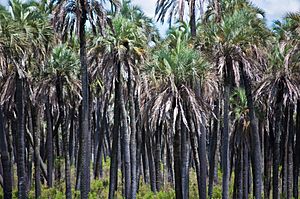
This palm grows slowly. It can reach 12 to 18 meters (about 39 to 59 feet) tall. Its trunk can be about 50 centimeters (20 inches) wide. It often grows in large, old groups in savannah areas. These areas are called pampa in Brazil.
It usually grows in sandy soils. These soils are often rockier than where other Butia palms are found. It can grow at altitudes from sea level up to 500 meters (1,640 feet).
The palm produces many fruits in the summer. Its seeds sprout in the wild during spring or fall.
The nuts of this palm were once thought to be the main food for the glaucous macaw. This was in 1993, but how these palms are classified has changed since then.
The Butia yatay is also a natural host for the larvae (caterpillars) of a large moth. This moth is called Paysandisia archon. The moth attacks the inside of the palm's trunk. This can sometimes kill the palm. The moth prefers palms with hairy trunks because it uses the fibers to build its cocoon.
Growing Butia yatay
The seeds of Butia yatay are collected in Brazil. They are then sold around the world for people to grow as ornamental plants.
It is best to plant these palms in full sunlight. They can handle cold temperatures down to -12 °C (10 °F). However, it is advised to protect them if the temperature drops to -5 °C (23 °F).
This palm is commonly grown and sold in Japan. People there use it as a decorative plant in their lawns.
Protecting This Palm
In 2008, the conservation status of Butia yatay in Brazil was listed as 'data deficient'. This means there wasn't enough information to know how threatened it was. By 2012, its status was changed to 'vulnerable' in Brazil.
Even though it grows over a large area, its natural homes are shrinking. This is because more land is being used for farming and growing trees for wood.
Some Butia yatay palms are grown in special gardens to help protect them. These include the Botanical Garden of Rio de Janeiro and the Inhotim Botanical Garden in Brazil.
Gallery
-
A cultivated younger tree in Fortín Olavarría, Buenos Aires, Argentina, showing the persistent leaf bases and the spathes.
-
Flowers of Butia yatay in Quebracho, Paysandú Department, Uruguay.
-
A grove of old trees in situ at Quebracho, Paysandú Department, Uruguay.
-
Comparison of fruit by João Barbosa Rodrigues in 1901. B. yatay is 'A' (note the large fruit); B. odorata is 'B' & 'C', B. eriospatha is 'D', and Syagrus coronata is 'E'.
See also
 In Spanish: Butia para niños
In Spanish: Butia para niños
- El Palmar National Park
- Mburucuyá National Park


